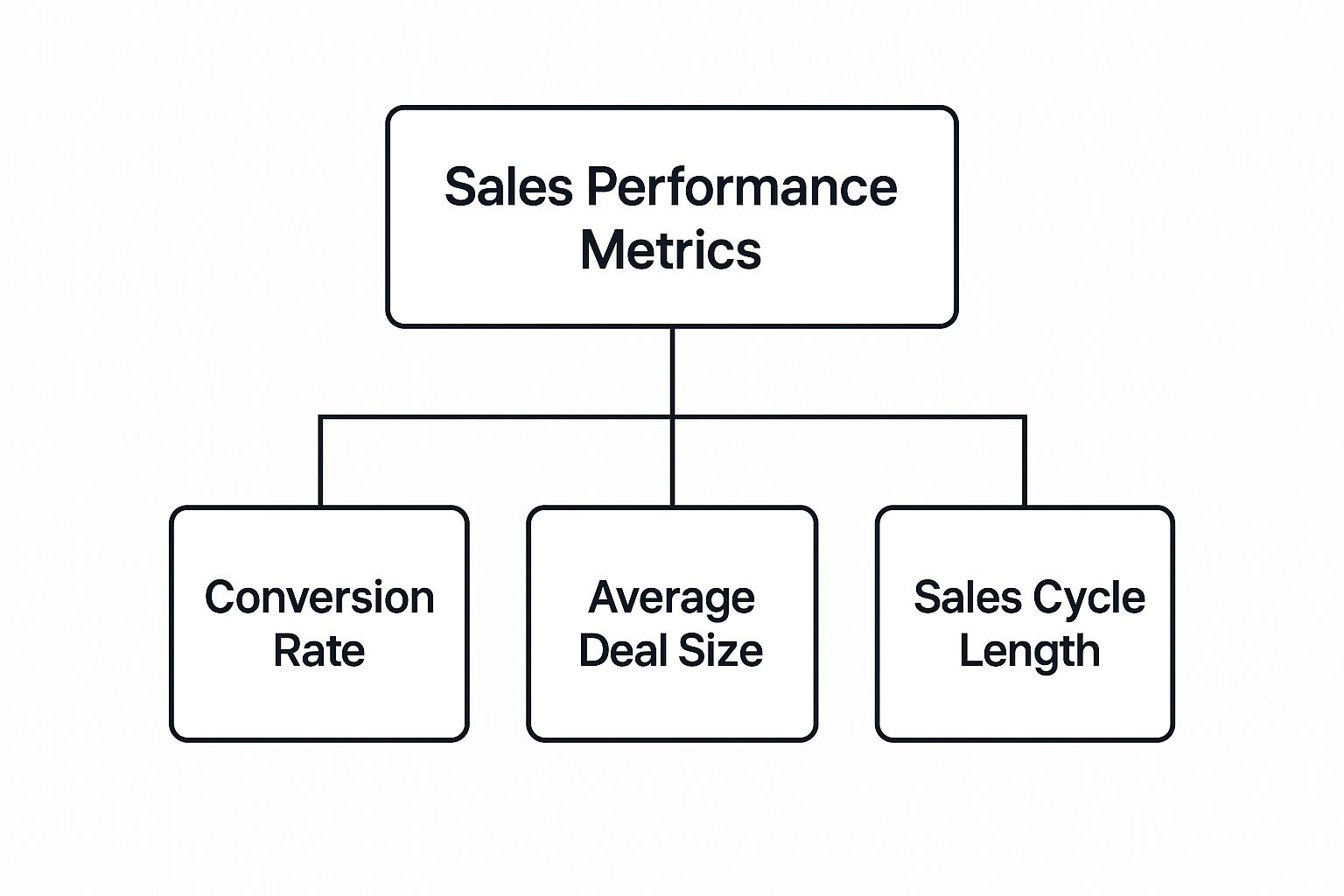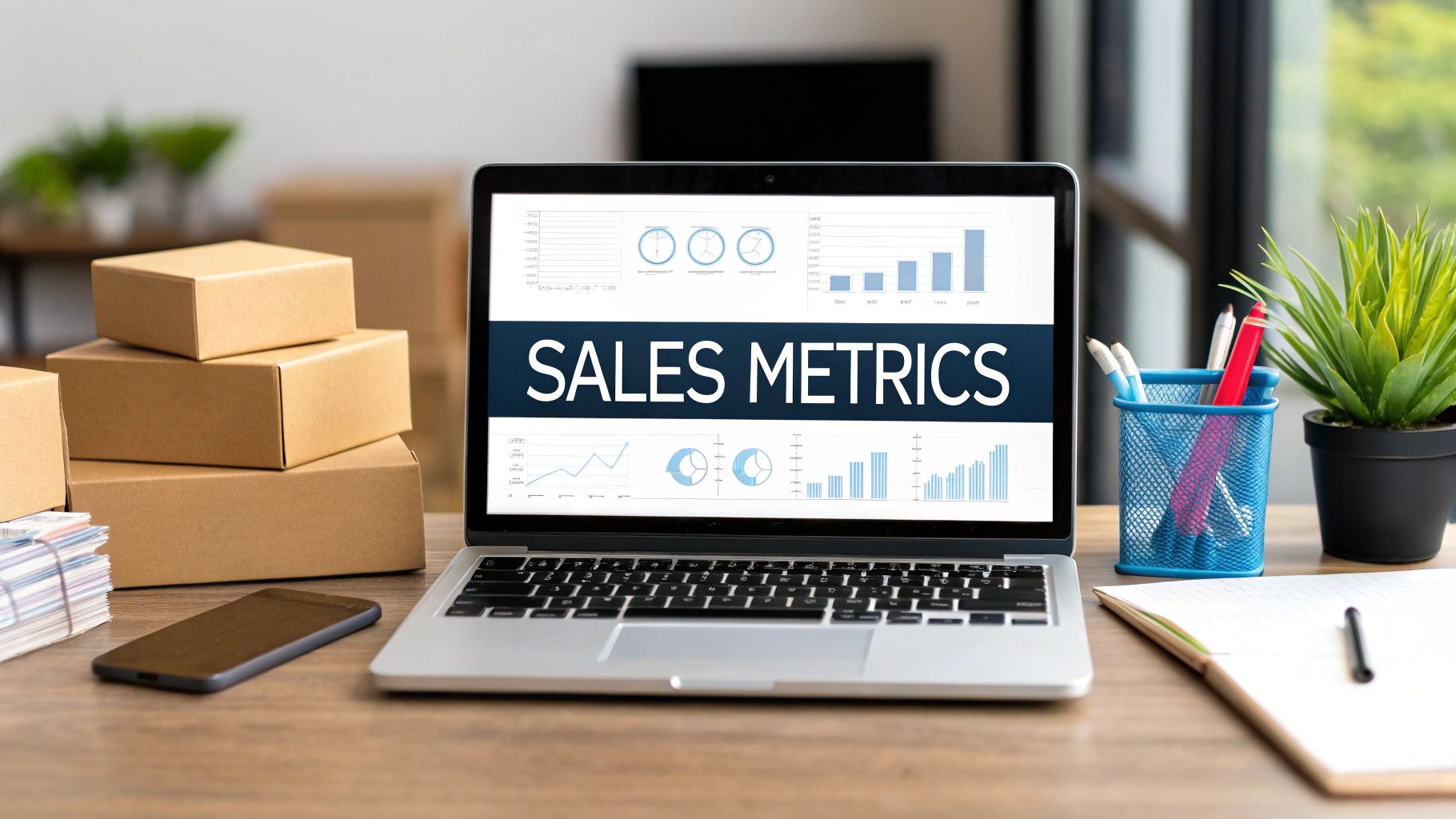Staring at your Shopify dashboard can feel like you're drowning in data, but are you actually tracking the numbers that lead to profit? Let's be honest: many e-commerce brands celebrate rising revenue while their profit margins are quietly bleeding out. This is a common mistake we see every day. The hard truth is that relying on vanity metrics like total sales is like judging a marathon runner by their first mile—it tells you nothing about whether they'll finish the race.
The real challenge isn't a lack of data; it's knowing which sales performance metrics truly matter. In this playbook, you'll learn exactly how to move beyond surface-level numbers and focus on the metrics that drive sustainable, profitable growth. We'll show you how to diagnose hidden problems in your sales funnel and use powerful channels like WhatsApp to fix them for good.
Why Your Sales Reports Might Be Misleading You

Let's be honest, watching your revenue chart climb feels incredible. But after helping hundreds of Shopify stores, we've seen firsthand how top-line revenue can mask some pretty serious underlying problems.
A common trap we see is brands celebrating sales growth while their profits are secretly bleeding out. It's easy to get fixated on that big revenue number, but that single metric doesn't tell the whole story. Are these profitable sales? Are the customers you're acquiring coming back to buy again? Is your cost to get that customer sustainable? Relying only on revenue is a recipe for disaster.
Moving Beyond Vanity Metrics
The real challenge for growing e-commerce brands isn't a lack of data; it's being drowned in a sea of misleading vanity metrics. These are the numbers that look impressive on the surface but don't actually contribute to a healthy, sustainable business.
The strategy that consistently delivers the best results for our clients is making a crucial shift. They move their focus from vanity metrics (like total revenue) to actionable intelligence (like Customer Lifetime Value and Profit Margin per Sale). This is the absolute key to building a resilient, data-driven sales engine.
This isn't just a matter of preference; it's a necessity for survival. Consider that a staggering 84% of sales representatives recently failed to meet their quotas, highlighting a massive gap in sales effectiveness. The research on sales effectiveness metrics shows that top-performing teams fight this by breaking down their sales performance metrics into smaller, more meaningful chunks—by product line, region, and customer type—to uncover what truly drives growth.
The True Cost of a Leaky Funnel
When revenue is your only guide, you completely miss the leaks in your sales funnel that are quietly draining your profits. Things like high cart abandonment rates, low repeat purchase rates, and long sales cycles are the silent killers of growth. Each one represents lost money and wasted effort.
To truly scale, you need to look at a combination of metrics. In this guide, we’ll give you a clear framework to:
- Identify the right sales performance metrics that actually impact your bottom line.
- Diagnose hidden problems in your sales process before they turn into full-blown crises.
- Take concrete action to plug those leaks and fine-tune every stage of your customer's journey.
We’re going to move past the textbook theory and give you the practical strategies we use with our own clients to turn raw data into real dollars. It’s time to understand the true story your numbers are telling you.
A Simple Framework for Your Sales Metrics
Diving into analytics can feel like trying to drink from a firehose. With countless data points available, it’s easy for any e-commerce manager to feel completely overwhelmed. After working with over 500 Shopify stores, we've seen the same mistake crop up time and again: brands try to track everything at once, and in the end, they track nothing effectively.
To cut through the noise, we've found it's best to group all sales performance metrics into three straightforward, powerful categories. Think of it as a complete health check for your business, giving you a 360-degree view of how your sales engine is really running.
This visual helps show how the most important metrics connect with one another.

As you can see, metrics like Conversion Rate, Average Deal Size, and Sales Cycle Length are the core pillars holding up your sales performance. They don't exist in a vacuum. To make sense of it all, we break them down into three distinct types of metrics. Understanding these categories is the key to knowing not just what is happening, but why.
The 3 Core Categories of Sales Performance Metrics
This table gives you a quick overview of how we organize metrics. Each category answers a different, vital question about your business.
Now, let's dig into what each of these categories actually tells you and why they matter.
H3: Activity Metrics: Are We Doing Enough?
First up, we have Activity Metrics. These are the most basic numbers you can track, and they measure the raw effort your sales and marketing teams are putting in. Think of them as your "input" metrics.
You're essentially asking, "How much work are we doing?" Examples include the number of WhatsApp messages sent, discovery calls made, or social media posts published.
But be careful. Activity alone is just noise. Sending 1,000 WhatsApp messages is great, but it means nothing if none of them spark a real conversation. From our experience, focusing on Reply Rate over "messages sent" gives you a much better signal of engagement. These metrics are the starting point, not the finish line.
H3: Pipeline Metrics: Is Our Work Effective?
This is where things get really interesting. Pipeline Metrics tell you how effectively your activities are moving potential customers through your sales funnel. They are a direct reflection of your process's health.
These metrics answer the crucial question: "Is what we are doing actually working?" Think of your Lead Conversion Rate, MQL-to-SQL rate, or Sales Cycle Length.
A dip in these numbers is an early warning sign. It tells you there's a bottleneck or a leak somewhere in your funnel that needs your immediate attention—before it starts hurting your revenue.
H3: Outcome Metrics: Did We Hit Our Goals?
Finally, we have Outcome Metrics. These are the bottom-line results that all your team's effort and process tuning lead to. They measure the ultimate business impact. Frankly, these are the numbers your leadership and investors care about most.
They answer the ultimate question: "Did we achieve our financial goals?" Key examples here are Total Revenue, Customer Lifetime Value (LTV), and Customer Acquisition Cost (CAC).
The Kanal Expert Take: The real magic happens when you see how all three categories are connected. A drop in Outcome Metrics (like revenue) can almost always be traced back to a problem in your Pipeline (like a low conversion rate), which might stem from an issue with your Activity (like not sending enough of the right kind of messages).
A truly comprehensive strategy doesn't stop at sales, either. To get the full picture of your customer's journey, you need to look at adjacent areas. For instance, connecting sales data with service quality is critical, which is why we also recommend tracking the key performance indicators for customer service. When you integrate these different data streams, you build a much richer, more accurate picture of your business's health.
Diagnosing and Fixing Your Sales Pipeline

If your e-commerce store is an engine, your sales pipeline is the transmission—it's what turns all that raw potential into actual forward motion. After working with countless brands, we’ve seen that this is precisely where most revenue gets lost, usually due to hidden friction and bottlenecks that quietly bleed profits. Focusing on pipeline sales performance metrics is like running a diagnostic to find and fix those leaks before they stall your growth.
A classic—and costly—mistake we see is letting hot leads go cold. You've spent good money to get their attention, but a slow or clunky follow-up process kills all momentum. Just think about it: a customer adds a high-value item to their cart, gets distracted, and then… crickets. Every minute that passes without a timely nudge is a sale slipping through your fingers. This is where your pipeline metrics become your most valuable guide.
Key Pipeline Metrics You Must Track
To spot these leaks, you have to look past the surface-level numbers. Here are the three pipeline metrics we tell our clients to become absolutely obsessed with:
- Lead Response Time: This is all about speed. It measures how quickly you engage with a new lead or a key customer action, like an abandoned cart. In e-commerce, a "lead" isn't just a form fill; it's a customer asking a question, a new subscriber, or someone who just left a full cart behind. The goal here is to be as close to instant as possible.
- MQL to SQL Conversion Rate: This metric tracks how many of your Marketing Qualified Leads (MQLs)—say, someone who signs up for your newsletter—actually turn into Sales Qualified Leads (SQLs) who are ready to have a real sales conversation. A low rate here is a red flag that your marketing isn't attracting the right audience or your initial messaging isn't hitting the mark.
- Sales Cycle Length: Put simply, this is the average time it takes to convert a prospect into a paying customer. A long, drawn-out cycle can be a massive drain on your resources and cash flow. Shortening it means you get revenue in the door faster. It's as simple as that.
How to Shorten Your Sales Cycle with WhatsApp
A long sales cycle is often just a symptom of bad communication. Emails get buried, social media DMs are easy to ignore, and before you know it, the customer has moved on. This is where shifting the conversation to a direct, instant channel like WhatsApp can completely change the game.
The Kanal Expert Take: We've seen clients slash their sales cycle length by up to 40% just by swapping out sluggish email follow-ups for automated WhatsApp flows. When a customer abandons their cart, they can get a helpful, non-pushy message in minutes, not hours or days. This single change can dramatically boost your pipeline's velocity.
Here’s a real-world example from a brand we work with: A Shopify store selling custom jewelry was dealing with a 14-day sales cycle because customers always had questions about engraving options. By setting up a Kanal flow that automatically answered these common questions via WhatsApp, they cut that cycle down to just 3 days and boosted their MQL-to-customer conversion rate by 22%.
Plugging the Leaks in Your E-commerce Funnel
Your sales pipeline is just one piece of the puzzle. To truly dial in your performance, you need to understand the entire customer journey, from their first flicker of awareness all the way to becoming a loyal advocate. This means taking a deep dive into your whole funnel to see exactly where people are dropping off.
A complete e-commerce funnel analysis uncovers the weak spots you might otherwise miss entirely. Are you losing visitors on your product pages? Is your checkout process too confusing? Is your post-purchase follow-up practically non-existent?
When you combine a solid grasp of your funnel with the sharp pipeline metrics we've discussed, you start building a powerful, predictable system for growth. Your analytics tools are great for showing you where the leaks are, and conversational platforms like Kanal give you the tools to plug them—instantly and effectively.
Focusing on Metrics That Drive Real Profit
It's easy to get caught up in chasing high revenue numbers. They look great in headlines, but after working with hundreds of growing brands, we’ve learned a hard truth: profit is what actually builds a sustainable business. A common mistake we see is a fixation on top-line sales. It's like flooring the gas pedal in your car to celebrate how fast you're going, all while ignoring the fuel gauge hitting empty.
This section is all about shifting your focus to the outcome metrics that really matter for a healthy e-commerce store. These are the bottom-line figures that tell you if all your hard work is actually paying off. They help you move past the question, "Are we busy?" and start asking, "Are we profitable?"
The Big Three Outcome Metrics
When you're trying to get a true pulse on your business's financial health, you need to zero in on three core sales performance metrics:
- Average Order Value (AOV): This is simply the average amount a customer spends every time they make a purchase. The formula is straightforward: AOV = Total Revenue / Number of Orders. Getting customers to spend just a little bit more per order is one of the quickest ways to grow revenue without needing a single new visitor.
- Customer Lifetime Value (LTV): This metric looks at the bigger picture, forecasting the total amount of money a single customer is likely to spend with you over their entire relationship with your brand. Think of it as the ultimate report card for customer loyalty and retention.
- Customer Acquisition Cost (CAC): This is what it costs you, in both sales and marketing dollars, to bring a new customer through the door. You calculate it like this: CAC = Total Sales & Marketing Spend / Number of New Customers Acquired. A low CAC is good, but it's only one half of the story; it’s almost meaningless without knowing your LTV.
These metrics don’t exist in a vacuum. The real magic happens when you see how they work together, which leads us to the most important equation in e-commerce.
The Gold Standard LTV to CAC Ratio
The relationship between what you spend to get a customer (CAC) and what that customer spends with you over time (LTV) is the ultimate stress test for your business model. This is your LTV:CAC ratio.
The Kanal Expert Take: From our experience with over 500 Shopify stores, the strategy that consistently points to long-term success is aiming for an LTV:CAC ratio of at least 3:1. This means that for every dollar you spend to acquire a customer, you earn three dollars back over their lifetime. That 3:1 benchmark is the gold standard for profitable, sustainable growth.
If your ratio is below 1:1, you're actively losing money on every new customer. A 1:1 ratio means you're just breaking even on your marketing spend. But once you hit that 3:1 mark, you’ve built a healthy, profitable engine that you can confidently invest more into. To figure out where you stand, plug your numbers into our free customer lifetime value calculator for an instant snapshot.
Driving Real Profit with WhatsApp
So, how can you actually improve these vital outcome metrics? This is where conversational commerce, especially on a platform like WhatsApp, becomes a game-changer. It opens a direct line to your customers, allowing you to build relationships that naturally increase both AOV and LTV.
To Boost Your Average Order Value:The perfect moment to increase an order's value is right before checkout. With our clients, we implement a simple yet incredibly effective WhatsApp flow to offer smart upsells.
- Trigger: A customer adds an item to their cart.
- Action: An automated WhatsApp message fires off instantly: "Great choice! Customers who bought the [Product Name] also loved our [Complementary Product]. Want to add it to your order for 15% off?"
- Result: This timely, relevant offer feels like a helpful suggestion, not a pushy sales tactic, and directly increases the average order value.
To Supercharge Your Customer Lifetime Value:It's far more cost-effective to bring back an old customer than it is to find a new one. To boost LTV, we recommend setting up a simple re-engagement campaign.
- Trigger: It's been 30 days since a customer's last purchase.
- Action: Send a friendly, automated WhatsApp message: "Hey [Customer Name]! It's been a while. We miss you! As a thank you for being a loyal customer, here’s a special 20% off code for your next order: VIP20."
- Result: This personal touch makes customers feel valued and encourages them to come back, which directly boosts your LTV.
Focusing on these outcome-driven strategies is critical, especially when you learn that the industry-wide average sales win rate hovers at a mere 21%. By improving metrics like LTV and AOV, you squeeze more value out of every single win, making your entire sales operation more efficient and profitable.
Bringing Your Sales Metrics to Life in Kanal

Theory is one thing, but profit is made through action. So, let's roll up our sleeves and apply the frameworks we've covered. This is where we move from concepts to cash flow, using Kanal's built-in tools to track the sales performance metrics that actually matter.
A common mistake we see is brands tracking their marketing in one place and their sales in another. It creates a data black hole. You know how many messages you sent, but you have no clue if they actually made you money. As an official Meta Business Partner, we built our analytics dashboard to solve this exact problem.
Connecting Your Actions to Real-World Outcomes
Think of your Kanal dashboard less as a simple report and more as a command center. It’s designed to connect your marketing activity directly to your sales pipeline and, ultimately, your bottom line. It’s the difference between guessing and knowing. For the first time, you can see the clear, undeniable ROI of every WhatsApp campaign you send.
Here’s a quick look at how Kanal helps you track metrics across all three core categories:
Activity Metrics: Sure, you can see sends, deliveries, and reads. But we push you to go deeper. By tracking Reply Rates, you get a true sense of engagement—a far more meaningful metric than just shouting into the void.
Pipeline Metrics: Every automated flow you build in Kanal, whether it's for cart recovery or a new customer welcome, comes with its own performance data. You can see the precise conversion rate for each automation, telling you exactly which messages are compelling customers to take the next step.
Outcome Metrics: This is where the magic really happens. Thanks to a deep integration with Shopify, Kanal ties revenue directly back to your WhatsApp messages. You can see the total revenue, the number of orders, and the exact ROI your campaigns are generating.
The Kanal Expert Take: There’s nothing more powerful than knowing a specific WhatsApp flow just recovered $10,000 in what would have been lost sales. That’s the kind of clarity our dashboard delivers. It ends the internal debate about whether conversational marketing is working by showing you the cold, hard cash.
This screenshot is a perfect example of what we're talking about—clean, actionable data that connects your WhatsApp efforts to your revenue goals. You can instantly see the money you’ve made, the orders you’ve secured, and the direct ROI, proving the value of every single message.
Your Quick-Start Dashboard Setup
Getting your tracking up and running is straightforward. You don't need to be a data scientist; you just need to know which questions you want to answer.
Start with the End Goal: Pin the "Revenue" and "Orders" widgets right at the top of your dashboard. This keeps your ultimate goal front and center every time you log in.
Monitor Your Pipeline Health: Keep a close eye on the performance of your most critical automations. For most e-commerce stores, this is the abandoned cart recovery flow. Check its conversion rate weekly. If you see a dip, you know it's time to tweak your messaging.
Check Your Campaign Pulse: When you launch new campaigns, look at the Reply Rate. A low reply rate is your earliest warning sign that the offer or the copy isn't hitting the mark with your audience.
By setting up this simple dashboard, you create a powerful feedback loop. You can launch a campaign, see its immediate financial impact, and make informed decisions to improve performance. This is how you stop guessing and start building a predictable revenue engine for your business.
Your Action Plan for Data-Driven Growth
Alright, we've walked through the key sales performance metrics that really separate the stagnant stores from the top-tier e-commerce brands. But knowing this stuff is one thing; actually using it is what builds an empire. It's time to stop guessing and start building a system that delivers predictable growth.
From our experience with hundreds of Shopify stores, the winners are always the most disciplined. They don't just peek at their data. They build their entire sales strategy around it. The goal here is to create a simple, repeatable process for turning those numbers into real revenue.
Your Four-Step Weekly Cadence
This isn't about making your week more complicated. It’s about zeroing in on what truly moves the needle. Here is the exact four-step plan we give our clients to help them build a predictable revenue engine.
Define Your Core Metrics: First, pick one crucial metric from each of the three categories we covered: Activity, Pipeline, and Outcome. For instance, you could start with Reply Rate (Activity), Cart Recovery Rate (Pipeline), and your LTV:CAC Ratio (Outcome). The key is to keep it simple, especially at the beginning.
Build Your Tracking Dashboard: Next, pop those core metrics into your Kanal analytics dashboard so they’re front and center. This makes it incredibly easy to see the direct connection between your WhatsApp marketing efforts and your financial results, all in one spot.
Schedule a Weekly Review: Block out 30 minutes on your calendar every single week. No skipping. Use this time to scan your dashboard for trends. Is your cart recovery rate starting to dip? Did that new campaign give your reply rates a nice boost? You want to catch these things early, before they ever have a chance to hurt your bottom line.
Act on Your Insights: This is the most important step of all. Data is just noise if you don't do anything with it. If a flow's conversion rate is lagging, it’s time to A/B test a new message. If a campaign is crushing it, double down. This constant cycle of tweaking and improving is the real secret to data-driven growth.
The Kanal Expert Take: We see a lot of brands overcomplicate this. You don't need to track dozens of metrics right away. Just pick a few vital ones, track them like a hawk, and act on what you see. This simple rhythm is how you build a sales process that can weather any storm.
Following this plan flips your sales strategy from being reactive to proactive. You’ll spend less time putting out fires and more time building a finely-tuned machine. For more hands-on strategies you can use today, dive into our complete library of e-commerce marketing playbooks.
Frequently Asked Questions
You’ve got the frameworks and the action plan. Now, let's dive into some of the most common, practical questions we hear from e-commerce brands when they start getting serious about tracking sales performance metrics. Getting these details right can make all the difference.
How Often Should I Review My Sales Metrics?
That's a fantastic and crucial question. In our experience helping brands get set up on Kanal, there’s no single right answer—the ideal review cadence depends on the metric. A one-size-fits-all approach just doesn't cut it.
Activity Metrics (Daily/Weekly): You'll want to keep a close eye on things like message sends and reply rates every day, or at least weekly. This lets you optimize active campaigns in real-time. If a flash sale announcement gets a poor reply rate, you can tweak your next message immediately instead of waiting.
Pipeline Metrics (Weekly): Metrics like your cart recovery rate and lead response time are best reviewed every week. This rhythm is perfect for spotting bottlenecks quickly before they turn into a major hit to your revenue.
Outcome Metrics (Monthly/Quarterly): High-level indicators like LTV and CAC are best reviewed monthly or even quarterly. They reflect your big-picture business strategy, so you need a larger data set to see trends that actually mean something.
The absolute key is consistency. Put a recurring reminder on your calendar and treat it like an appointment you can't miss.
What Is the Most Important Metric for an E-commerce Startup?
For a new e-commerce startup, the most critical indicator isn't just a single metric—it's a ratio: Customer Lifetime Value to Customer Acquisition Cost (LTV:CAC).
Honestly, we see so many new brands get fixated on a single number like total revenue, and this can be incredibly misleading. It's entirely possible to have soaring revenue while you're actually losing money on every single customer.
A healthy LTV:CAC ratio, ideally 3:1 or higher, is the ultimate proof that your business model is sustainable. Focusing on this calculation from day one is the strategy that sets our most successful clients up for long-term, profitable growth. It tells you that you can actually afford to scale.
My Win Rate Is Low. What Should I Do First?
A low win rate is a classic symptom of a leaky sales funnel. The first step isn't to change everything at once, but to play detective and figure out exactly where you're losing potential customers. Are they dropping off after the first contact? Or are you losing them after you send a price quote?
A common culprit we see all the time is a slow lead response time. When a customer shows interest—whether by asking a question or abandoning a cart—every minute that passes drastically reduces your chance of winning them over.
Our Recommendation: Start by tackling your speed. Implementing an automated welcome or cart recovery flow on WhatsApp through a tool like Kanal can instantly improve your response time. This simple, automated action qualifies leads faster and often provides a significant, immediate boost to your win rate.
How Does WhatsApp Marketing Improve These Sales Metrics?
WhatsApp directly and powerfully impacts metrics across all three categories. With its staggering 98% open rate, it's an unmatched channel for Activity metrics. You can be confident your messages are actually being seen.
Its conversational, instant nature helps slash Pipeline metrics like Sales Cycle Length and Lead Response Time. But most importantly, it drives real Outcomes.
You can use automated WhatsApp flows for cart recovery to boost your win rate, or run post-purchase upsell campaigns to directly increase AOV and LTV. From our experience, we've seen clients use Kanal’s abandoned cart recovery flows to increase their overall revenue by over 15%—a direct, measurable impact on the bottom line.
Ready to stop guessing and start building a predictable revenue engine? Kanal gives you the tools to track your sales performance metrics and the conversational flows to improve them.
Install Kanal on your Shopify store today or book a demo at getkanal.com/demo to see the difference for yourself.



